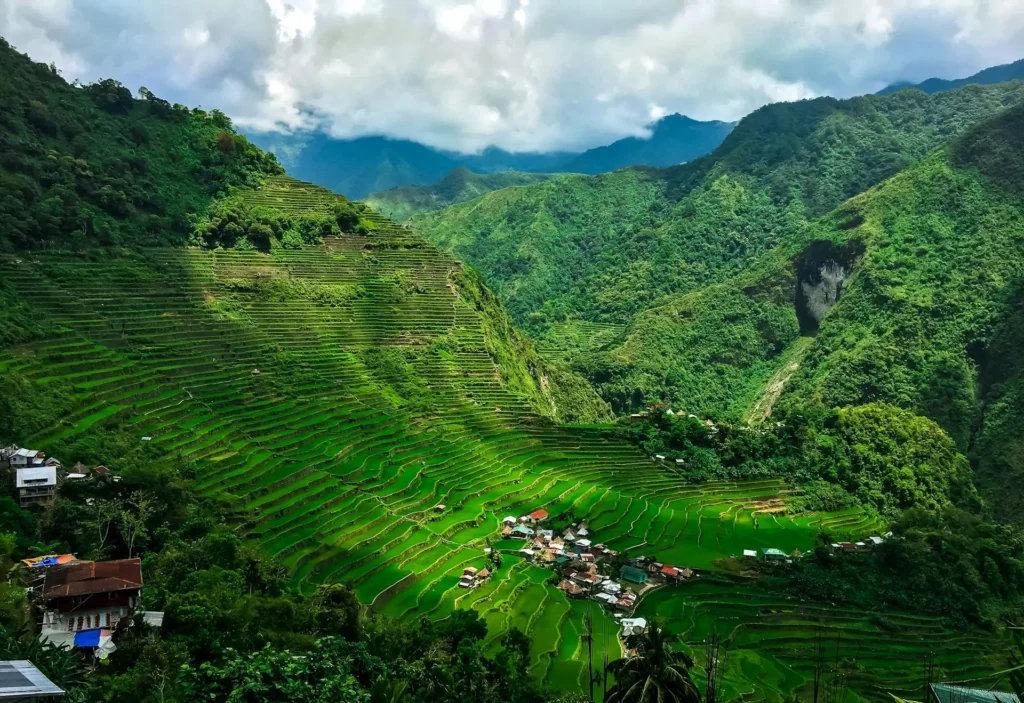Introduction
Imagine standing on the edge of the world, where mountains kiss the sky and the horizon stretches endlessly. The Banaue Rice Terraces, carved into the mountains of Ifugao in the Philippines, embody the breathtaking symphony between human endeavor and the natural landscape.
These ancient steps, meticulously sculpted by the Ifugao people over 2,000 years ago, are not just an agricultural wonder; they are a poignant reminder of the delicate balance between man and nature, a harmony that sings through every grain of rice that grows in these fields.
These are the essential tools for everyone interested in photography or videography:
- Best Camera: Sony a7 III ILCE7M3 (Best Deal)
- Best Action camera: AKASO EK7000 4K30FPS 20MP WiFi Action Camera (Best Deal)
- Best Drone: DJI Mini 4K (Best Deal)
Historical Background
The Banaue Rice Terraces are often referred to as the “Eighth Wonder of the World,” a title befitting their awe-inspiring grandeur. Their origins trace back to the ingenuity of the Ifugao people, whose mastery over their environment is evident in every tiered level of these terraces.
Over centuries, they developed an intricate system of water management and soil conservation, transforming rugged mountains into fertile farmland. This labor of love has been passed down through generations, preserving not just a way of life but a living museum of cultural heritage.
Geographical Setting
Nestled in the Cordillera mountain range of Luzon Island, the Banaue Rice Terraces stretch across the provinces of Ifugao, Benguet, and Mountain Province. These terraces are easily accessible from Manila, with a journey that weaves through picturesque landscapes, each turn revealing more of nature’s splendor. The terraces themselves are a marvel of human engineering, rising to an altitude of 1,500 meters (4,900 feet) and spanning an area of over 10,360 square kilometers (4,000 square miles). The sight of these terraces, rising like green stairways to the heavens, is nothing short of mesmerizing.
Cultural Significance
For the Ifugao people, the Banaue Rice Terraces are more than just an agricultural feat; they are a testament to their resilience and wisdom. These terraces have been a cornerstone of their culture, shaping their traditions, rituals, and way of life. Each stone placed, each canal dug, carries the weight of their ancestors’ dreams and aspirations. The terraces are a living canvas of their heritage, where every harvest festival and planting ritual is an ode to the land that sustains them.
Architectural Marvel
The architectural brilliance of the Banaue Rice Terraces lies in their sustainable design. Utilizing the natural contours of the mountains, the Ifugao people created a complex network of irrigation channels that capture and distribute water from the rainforests above. This system not only ensures a steady water supply but also prevents soil erosion, making the terraces a model of environmental stewardship. The use of local materials, such as stone and mud, further underscores their harmony with nature.

Agricultural Practices
The farming methods employed on the Banaue Rice Terraces are a blend of tradition and practicality. The Ifugao people practice a unique form of wet-rice agriculture, which involves planting rice in flooded fields. This method, coupled with their deep understanding of the seasons and weather patterns, has sustained them for millennia. Apart from rice, the terraces also support a variety of crops like sweet potatoes, vegetables, and legumes, ensuring food security and nutritional diversity for the community.
Ecological Importance
The Banaue Rice Terraces are a biodiversity hotspot, home to numerous plant and animal species. The terraces create a unique micro-ecosystem that supports a rich array of flora and fauna. The traditional farming practices employed here are inherently sustainable, relying on natural pest control and organic fertilizers. This ecological harmony not only preserves the environment but also enhances the resilience of the terraces against climate change.
Tourism and Economy
Tourism plays a pivotal role in the local economy of Banaue. Each year, thousands of visitors from around the globe are drawn to the terraces, captivated by their beauty and historical significance. This influx of tourists has spurred economic growth, providing livelihoods for many Ifugao families. From guided tours to handicraft sales, the terraces offer a multitude of opportunities for sustainable tourism, ensuring that the benefits are shared by the entire community.
Challenges and Conservation Efforts
Despite their grandeur, the Banaue Rice Terraces face numerous threats. Modernization, climate change, and the migration of younger generations to urban areas pose significant challenges. However, concerted efforts are underway to preserve this heritage site. Organizations, both local and international, are working to implement sustainable farming practices, promote eco-tourism, and raise awareness about the importance of conserving the terraces. These initiatives are crucial in ensuring that the Banaue Rice Terraces continue to stand as a beacon of human ingenuity and perseverance.
Personal Experience
Walking through the Banaue Rice Terraces is like stepping into a timeless tale. The air is thick with the scent of earth and the hum of nature. As the sun sets, casting a golden glow over the terraces, one can’t help but feel a profound connection to the generations of Ifugao farmers who have tended these fields. Each step on the ancient paths is a journey through history, each turn revealing a new facet of this living masterpiece. It’s an experience that leaves an indelible mark on the soul, a reminder of the beauty that arises when humanity works in harmony with the earth.
Cultural Festivals
The Ifugao people celebrate their heritage through vibrant festivals that bring the terraces to life. The annual Imbayah Festival is a grand spectacle of traditional music, dance, and rituals, showcasing the rich cultural tapestry of the region. These festivals are not just a celebration but a reaffirmation of their identity, a way to honor their ancestors and pass on their traditions to future generations. Through these communal gatherings, the spirit of the terraces is kept alive, echoing through the mountains and valleys.
Art and Craft
The influence of the Banaue Rice Terraces extends beyond agriculture into the realm of art and craft. The Ifugao are renowned for their woodcarvings, woven textiles, and intricate beadwork, all of which draw inspiration from their surroundings. These crafts are a manifestation of their deep connection to the land, each piece telling a story of their heritage and the natural beauty of the terraces. Visitors to Banaue can explore local markets and workshops, where artisans proudly display their creations, offering a glimpse into the rich cultural heritage of the Ifugao.
Legends and Folklore
The Banaue Rice Terraces are steeped in legends and folklore that add to their mystique. One popular tale speaks of an Ifugao god who descended from the heavens to teach the people the art of terracing. Another story tells of a heroic ancestor who carved the terraces with his bare hands to save his village from famine. These myths, passed down through generations, enrich the cultural fabric of the terraces, imbuing them with a sense of magic and wonder that captivates both locals and visitors alike.
Global Recognition
In 1995, the Banaue Rice Terraces were inscribed as a UNESCO World Heritage Site, a testament to their cultural and historical significance. This recognition has helped bring international attention to the terraces, highlighting their importance as a global heritage site. The terraces have also been featured in numerous documentaries, travel guides, and academic studies, further cementing their status as one of the world’s most remarkable agricultural landscapes. This global recognition has played a crucial role in the ongoing
efforts to preserve and protect the terraces for future generations.
Conclusion
The Banaue Rice Terraces are more than just a marvel of ancient engineering; they are a living testament to the harmony between humans and nature. These terraces, carved into the mountains with ingenuity and care, stand as a symbol of the Ifugao people’s resilience and their profound connection to the land. As we marvel at their beauty, we are reminded of the importance of preserving this heritage site, ensuring that future generations can continue to draw inspiration from this extraordinary example of sustainable living.
FAQs
What makes the Banaue Rice Terraces unique?
The Banaue Rice Terraces are unique due to their ancient engineering, cultural significance, and the sustainable agricultural practices of the Ifugao people.
How old are the Banaue Rice Terraces?
The Banaue Rice Terraces are believed to be over 2,000 years old, meticulously crafted by the Ifugao ancestors.
When is the ideal time to see the rice terraces of Banaue?
The best time to visit the Banaue Rice Terraces is during the dry season, from March to May, when the weather is ideal for trekking and the terraces are lush and green.
Are the Banaue Rice Terraces a UNESCO World Heritage Site?
Yes, the Banaue Rice Terraces were designated as a UNESCO World Heritage Site in 1995, recognizing their cultural and historical importance.
How can tourists help in preserving the Banaue Rice Terraces?
Tourists can help preserve the Banaue Rice Terraces by practicing responsible tourism, supporting local conservation initiatives, and respecting the cultural traditions of the Ifugao people.
Filipino Etag: Discover the distinct flavor of culinary traditions
Share this post: on Twitter on Facebook



I know this if off topic but I’m looking into starting my own blog and was curious what all is needed to get set up? I’m assuming having a blog like yours would cost a pretty penny? I’m not very internet smart so I’m not 100 positive. Any tips or advice would be greatly appreciated. Thank you
I am pleased that I detected this web site, exactly the right information that I was searching for! .